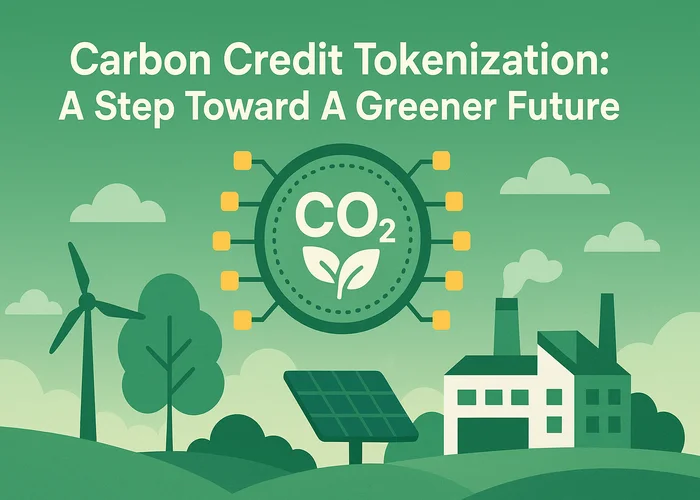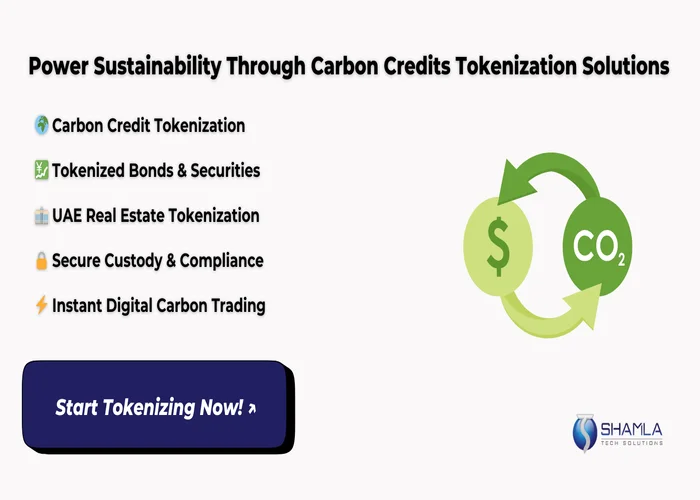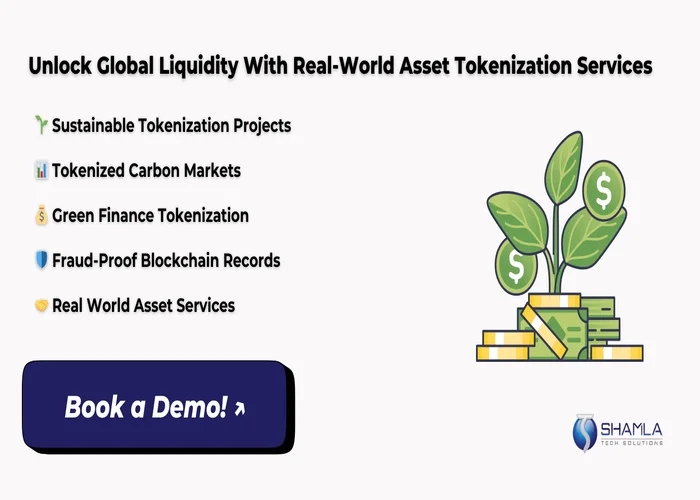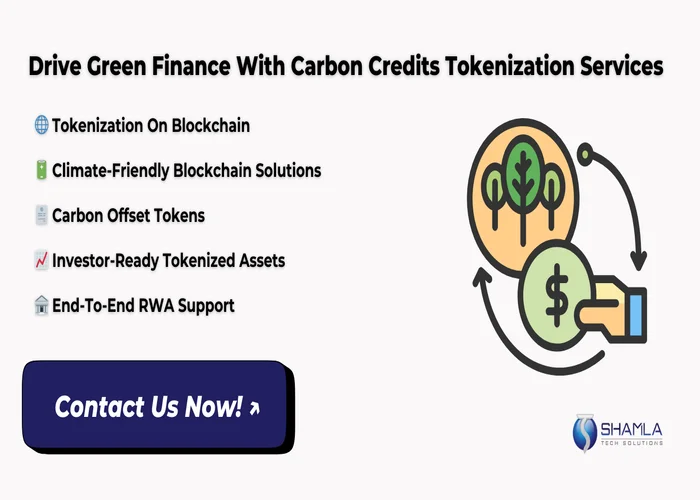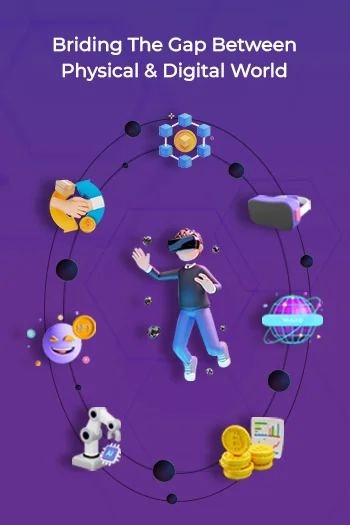Carbon credits assign measurable emission cuts to projects; carbon credit tokenization converts those cuts into digital tokens on ledgers, enabling exact tracking and instant settlement. By linking vintage, registry ID, and verifier notes to a token, market players trade real-time, auditable units.
Using carbon credits, blockchain records ownership, retirement, and transfer events in a way that cannot be changed, cutting fraud and double-counting. Green finance tokenization ties these tokens to simple investment products and crowdfunding, unlocking liquidity and letting small buyers hold parts of credits. Smart contracts cut fees, run verification steps, and trigger payouts automatically.
The Rise of Carbon Credit Tokenization
1. How Tokenization Converts Carbon Credits
Tokenization converts a carbon credit into a digital token that represents a fixed emission reduction. Issuers attach project ID, vintage, and verifier report to the token so buyers can check origin and quality. The token moves on a ledger when sold, and retirement means the token is marked used and cannot be traded again.
This process removes manual paperwork, reduces delays, and makes audits simple. By standardizing units and metadata, carbon credit tokenization helps small holders sell parts of credits and enables clear records for regulators and auditors, improving market access and lowering entry costs and supports clear price discovery.
2. Recording and Proof on Blockchain
This model underpins carbon credit tokenization across platforms. Ledgers record each token transfer, timestamp, and holder address so history stays visible and fixed. Validators check signatures and link tokens to registry entries for on-chain proof. Auditors pull events to confirm retirements and reconcile balances without paper trails.
Permissioned chains or public chains can both host these records, depending on privacy needs. Using carbon credits blockchain ensures that ownership moves and retirement flags cannot be hidden or changed, which reduces fraud and supports clear audit trails for buyers, project owners, and regulators. It also speeds verification and lowers compliance costs significantly.
3. Building Tokenized Carbon Markets
This design grew from carbon credit tokenization best practices. Market platforms list tokens with clear metadata, enable price bids, and settle trades instantly. Brokers and retail users can buy fractional lots, improving liquidity. Tokenized carbon markets use order books or automated pools to match buyers and sellers, and they show live supply and retirement status.
When a token is retired, the platform locks it and updates registries. Carbon offset tokens carry project checks and verifier stamps so buyers know what they fund. These setups power digital carbon trading and let investors move money faster while tracking real impact lower risk.
4. Carbon Offset Tokens in Practice
Project teams mint tokens only after registry validation and third-party checks. Carbon offset tokens link to public reports and verifier IDs so buyers can read proof without intermediaries. Market platforms mark retired tokens and push events to registries automatically. Using carbon credits blockchain, platforms reduce dispute time and let auditors pull proof from the chain.
This setup makes tracking simple for companies buying offsets and for auditors checking claims. It also shows how carbon credit tokenization enforces one-time use and clear ownership, stopping double sales and helping compliance. That reliability raises buyer confidence and speeds corporate reporting cycles and adoption.
Examples of Climate-Friendly Blockchain Solutions
Examples include public ledgers that record retirements, private chains that batch verifier reports, and hybrid systems that hide identities but share proof. A forestry project can mint tokens tied to GPS maps and sensor logs so buyers trace real trees. Tokenized carbon markets run on pooled liquidity protocols or exchange rails to let companies hedge emissions.
Startups offer wallets that show token origin and retirement badges. These climate-friendly blockchain solutions lower friction for small projects and let investors fund verified work quickly. Overall, carbon credit tokenization powers clearer markets and faster funding for green projects and expands investor access globally.
Green Finance Tokenization and Sustainable Projects
Green Finance Tokenization Drives Capital Flow
Green finance tokenization channels money into verified green work by turning project outcomes into sellable digital shares. Platforms list simple project facts, proof files, and expected impact so investors check claims quickly. Clearing steps automate payments to project accounts once third-party checks confirm emission cuts.
This method lowers the cash needed to start projects and opens funding to small buyers and local groups. Regulators get clearer logs for oversight and auditors can pull records without paper. Overall, this setup speeds funding, cuts middleman fees, links payment to verified results, and shortens funding lead times.
Sustainable Tokenization Projects in Action
Sustainable tokenization projects turn real-world work into clear, tradeable items that show proof and results. Project owners mint tokens only after third-party checks and link each unit to a registry entry. Platforms list supply, price, and retirement status so buyers see current availability.
Fractional ownership lets small contributors buy part of a verified project and share returns. Tokenized carbon markets add order matching and liquidity pools so trades settle fast and at low cost. Local teams gain steady income and clearer budgets. These projects cut middle layers and speed funding for on-ground climate work.
How Digital Carbon Trading Helps Investors?
Digital carbon trading puts buy, sell, and retire options on a ledger for instant action. Traders see price history, project proof, and retirement badges so choices match verified impact. Automated rules let firms set thresholds to buy or retire offsets when emissions rise. Buyers can acquire carbon offset tokens in small lots and retire them to show net reductions.
Clearing is faster, fees fall, and auditors can trace claims to on-chain events. It opens global buyers and gives projects steady predictable income streams. For investors, this means clearer risk, faster exits, and direct links to verified climate work.
Tokenized Carbon Markets: Market Structure and Trust
Market structure for token sales must balance proof, price, and custody to work well. Green finance tokenization uses clear mint criteria, escrow accounts, and simple fee rules so trust grows. Sustainable tokenization projects often include local compliance checks and community consent before tokens list.
Tokenized carbon markets add market makers and pooled liquidity to smooth price moves and let large buyers hedge. Governance rules set who can mint, who can retire, and how disputes resolve. Clear rules reduce fraud, let auditors reconcile easily, and make it simple for funds to allocate capital to verified work and speed capital deployment today.
Climate-Friendly Blockchain Solutions and Scaling
Climate-friendly blockchain solutions focus on low-energy chains, off-chain storage, and simple proof badges that buyers trust. These tools pair with green finance tokenization to cut fees and show clear proof of impact. Sustainable tokenization projects use sensor logs and verifier notes stored off-chain with hash links on ledger records.
With digital carbon trading integrated, buyers can view proof, buy carbon offset tokens, and retire units in one step. Such systems help small teams join markets and let investors check impact fast while keeping on-chain load low. Climate-friendly blockchain solutions also enable pooled reporting and lower energy use for token handling.
Tokenization beyond Carbon Credits
Tokenization for Real-World Assets
Tokenization for real-world assets turns legal rights into small digital tokens on a ledger. Platforms create tokenized assets from property, loans, and verified credits so small investors can buy parts. Real World Asset Tokenization services handle legal checks, identity checks, and custody to make tokens match real items.
Benefits include lower entry cost, faster funding, and clearer records. Platforms show supply, price, and status so investors pick pieces. For climate work, carbon credit tokenization links each token to a registry ID and verifier file so buyers see proof. Ledger entries replace paper, speed audits, and widen access.
Bond Tokenization Basics
Bond tokenization on blockchain breaks a bond into many small tokens that each show a share of interest and principal. This lets tokenized bonds trade in small lots and reach retail buyers. The power of bond tokenization is faster settlement, lower fees, and clear ownership. Issuers post coupon, maturity, and transfer rules on a ledger so buyers confirm cash flow fast. Custody and automated payouts reduce manual steps. Key points:
- Smaller lot sizes
- Instant settlement checks
- Simpler custody
This model links to carbon credit tokenization when green bonds fund verified emission cuts and share returns with investors.
Why Bond Tokenization Matters
The power of bond tokenization shows in better price finding and faster trades. Using bond tokenization on blockchain, market makers and pools run continuous markets with clear audit logs. Investors set rules to slice risk, auto-reinvest, or sell at target prices. Issuers cut distribution cost and keep clear records for regulators.
Risk models link token flows to events so risk checks run in real time. Custodians and compliance layers check identity and limits without slowing settlement. Overall, tokenized bonds boost access, lower friction, and give clear proof of ownership that suits fund managers and small buyers and improve market depth.
UAE Real Estate and Other Services
UAE Real Estate Tokenization lets owners split property into many tokens that show deed links and share rent. Ledgers record ownership changes and payments so buyers get fast proof and payouts. Real World Asset Tokenization services run legal checks, KYC, and custody so tokens match deeds and leases. Tokenized assets from buildings open global buyers and let developers raise funds without full bank loans. Platforms add reporting, fee rules, and clear exit steps. Benefits include broader investor pools, faster project funding, and simpler records. Key services:
- Legal checks
- Identity verification
- Custody and payout automation and faster closing
How Tokenized Assets Support Carbon Markets
Tokenized assets and tokenization on blockchain help carbon credit tokenization by adding money and trust. Real World Asset Tokenization services bring legal processes and custody that let funds accept offset tokens as proof. UAE Real Estate Tokenization platforms can sell property upgrades with linked offsets so buyers fund cuts directly.
Using carbon credits blockchain, traders and auditors confirm retirements and trace payments to projects. This mix lets lenders accept offset tokens, lets funds package climate income, and speeds capital to verified projects. The result is clearer claims, faster funding, and wider investor access to green work and better reporting standards.
Conclusion
Carbon credit tokenization speeds funding, cuts fraud, and makes tracking clear. Using ledgers, carbon credit tokenization ties units to proof and forces one-time retirement. Carbon offset tokens enable instant settlement and custody, while tokenized carbon markets boost liquidity and let buyers see verified impact before they buy.
Shamla Tech is a leading RWA tokenization company that helps businesses turn real-world assets into tradable tokens. We help businesses tokenize carbon credits, bonds, real estate, and other real world assets, set up custody and compliance, and provide platforms so clients raise funds faster and list assets to global buyers everywhere securely.
Start your journey into sustainable finance today with secure, transparent RWA tokenization solutions!
Contact us today to tokenize carbon credits, bonds, or real estate and unlock global investor access!

